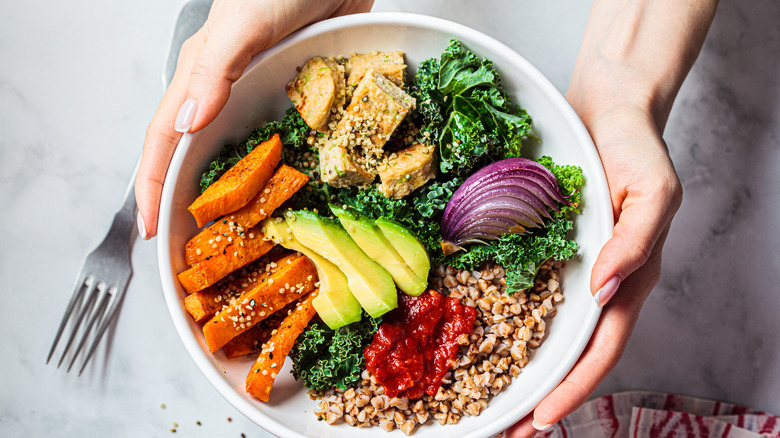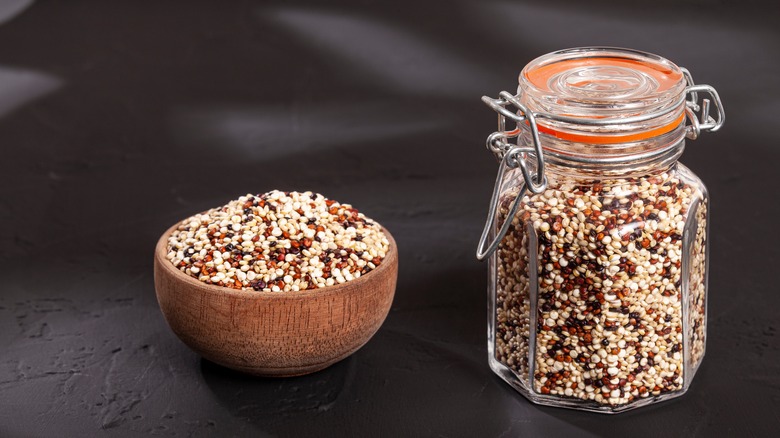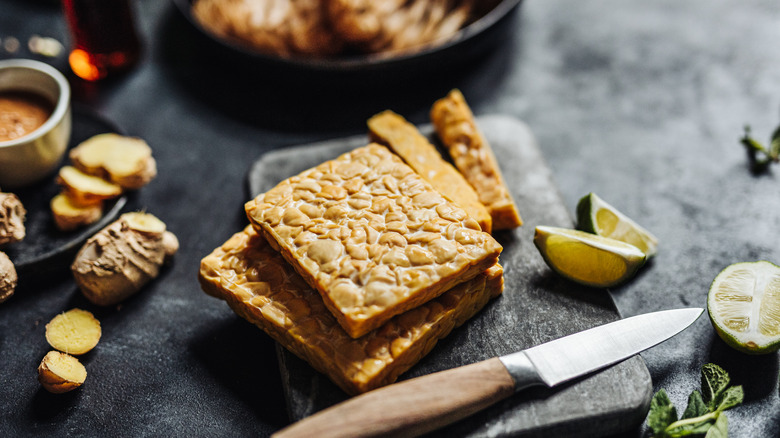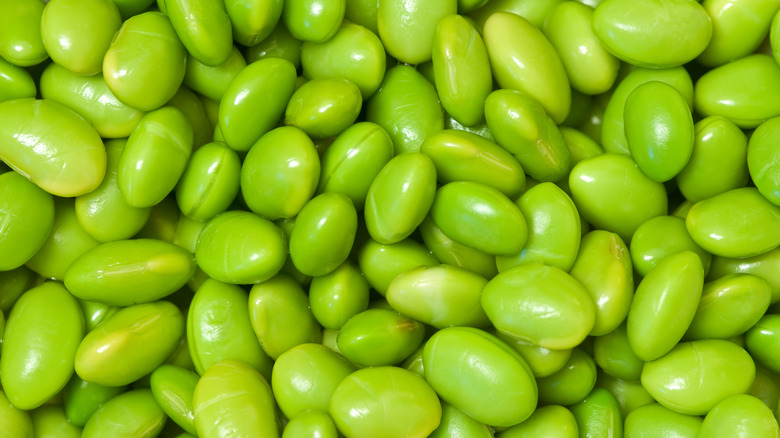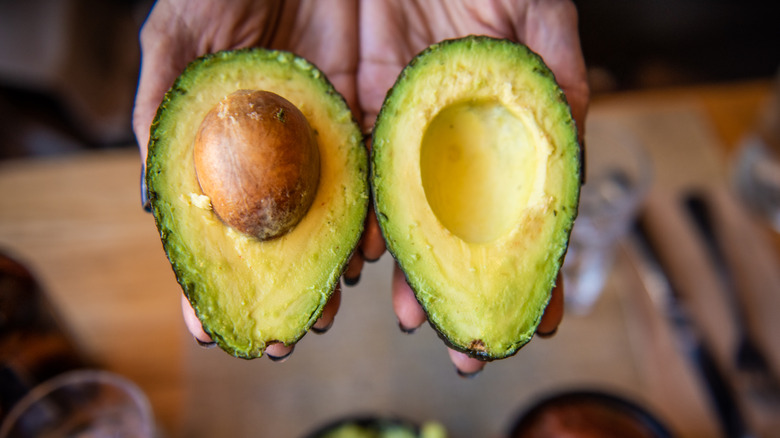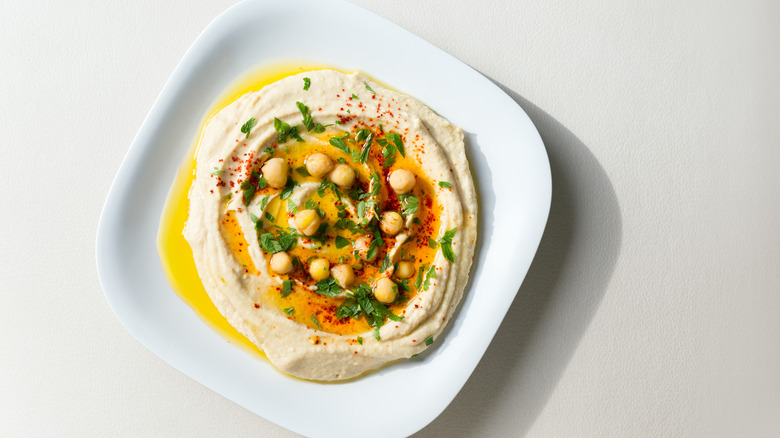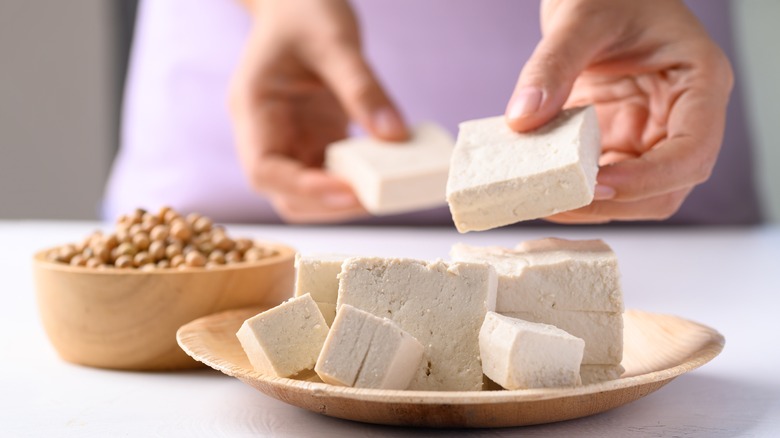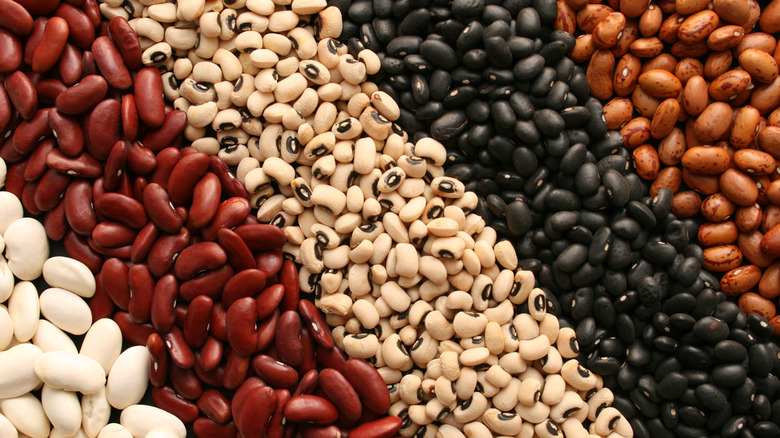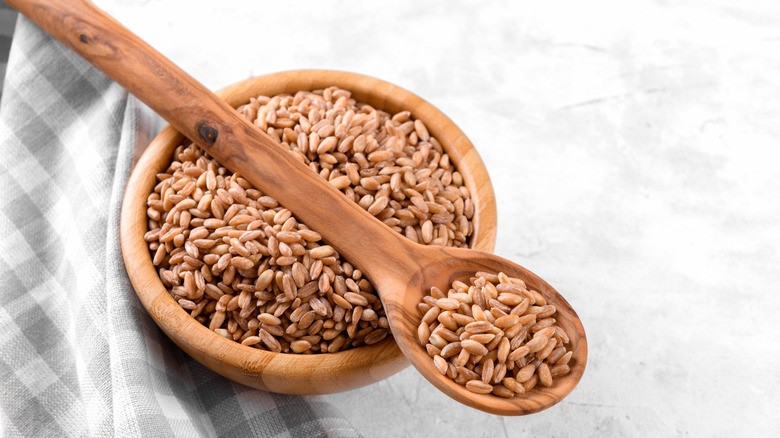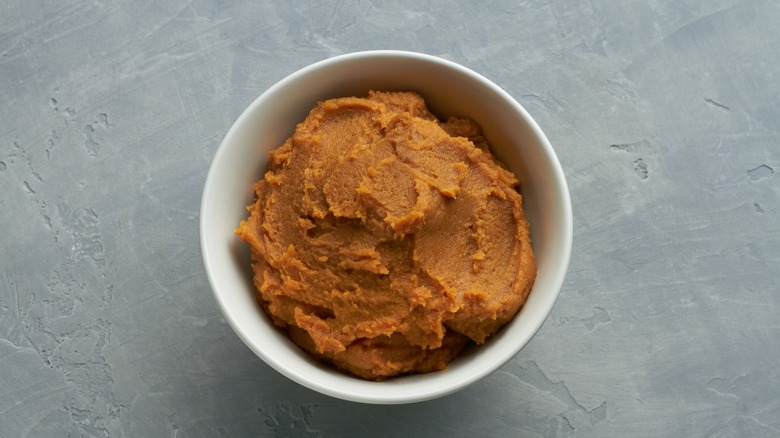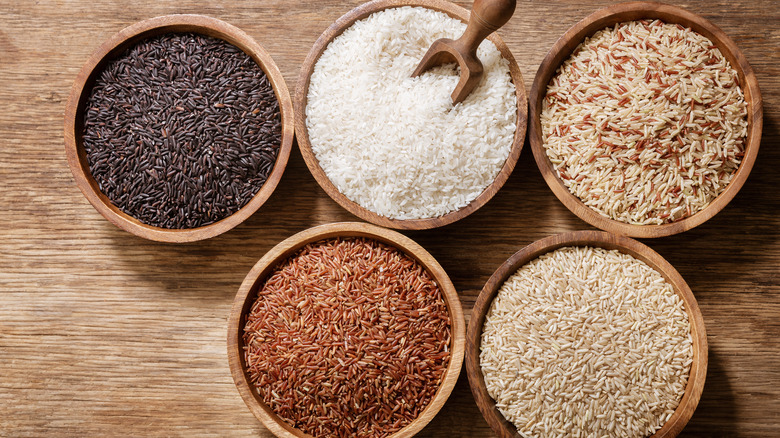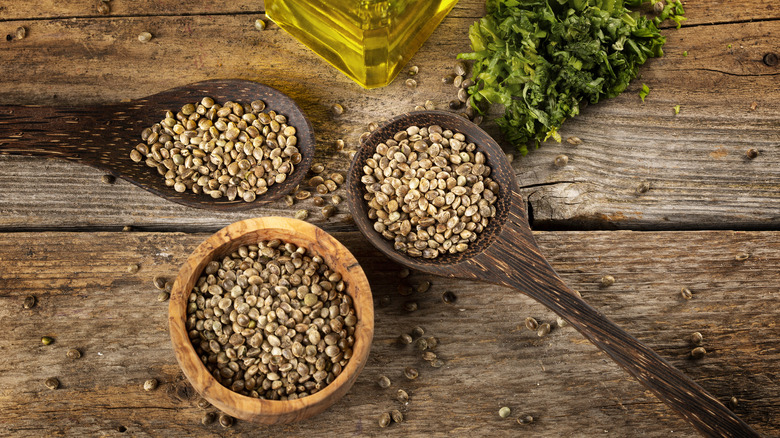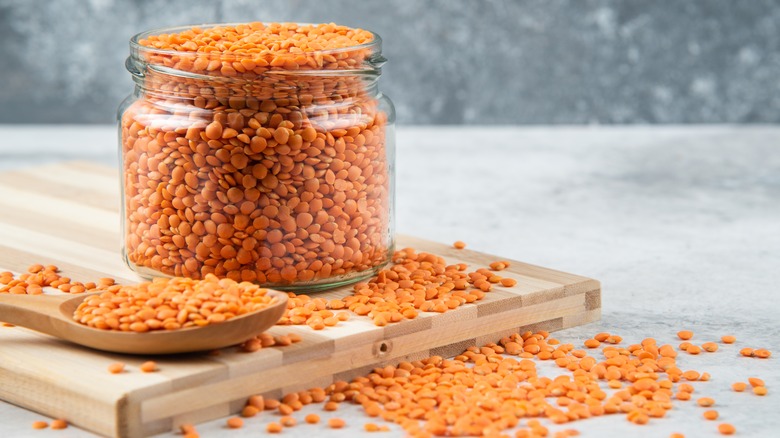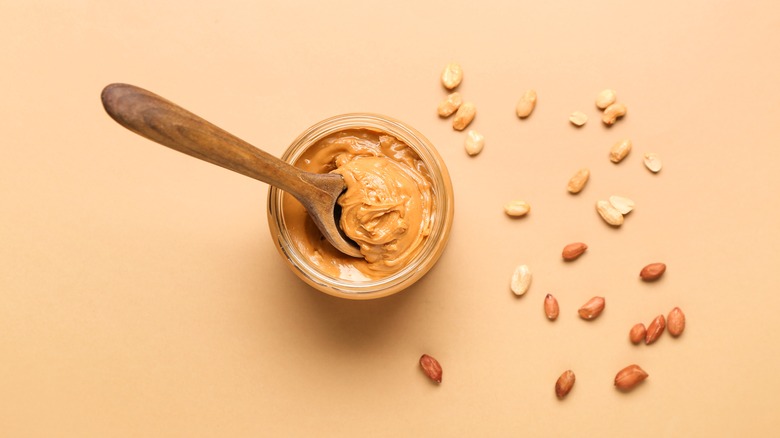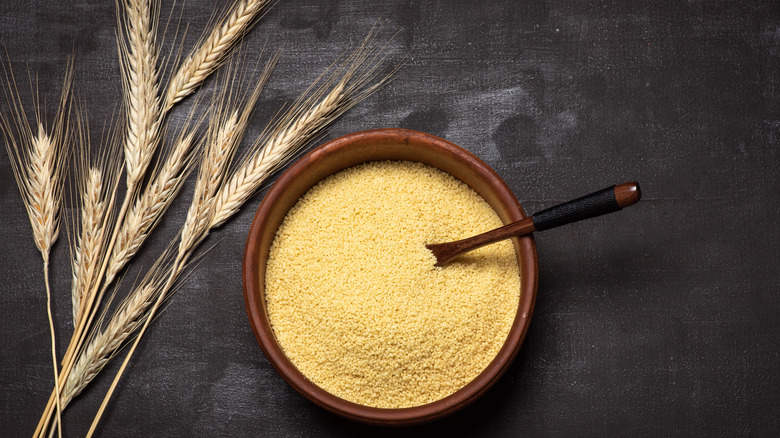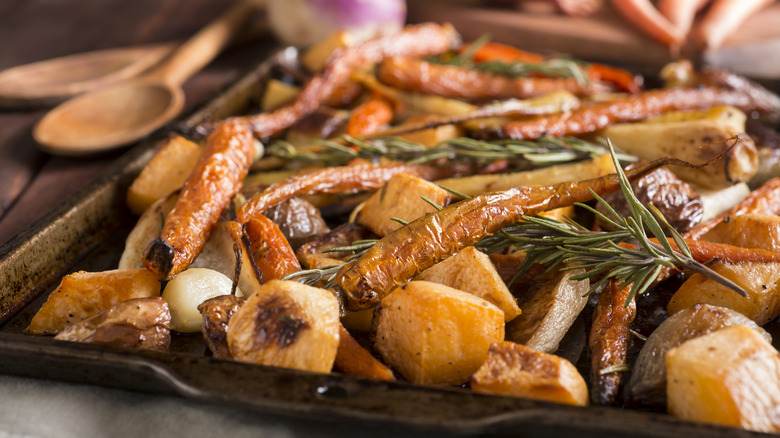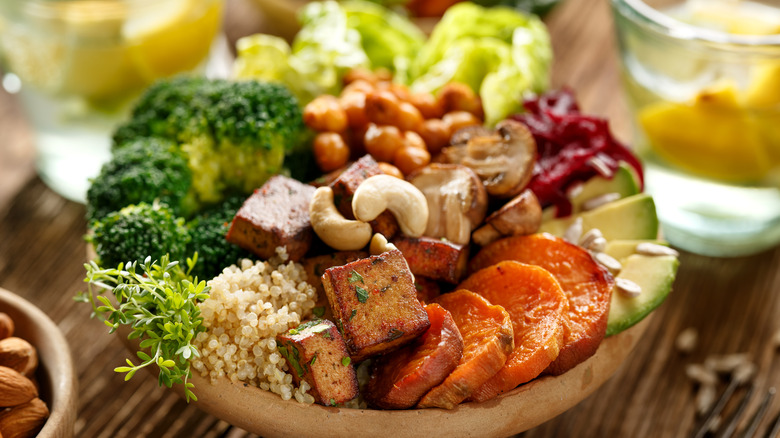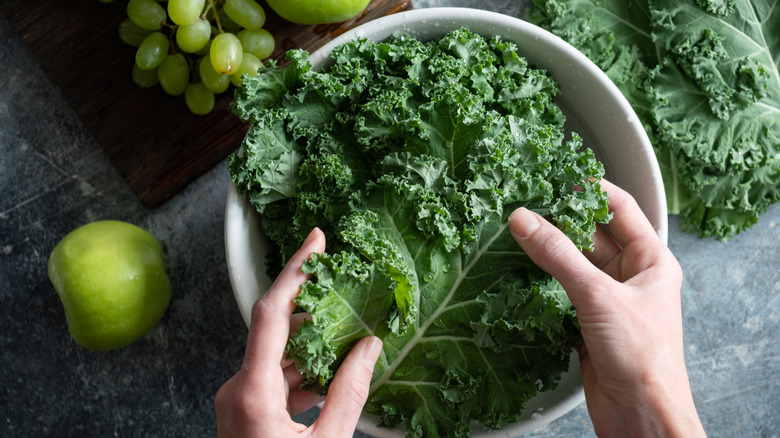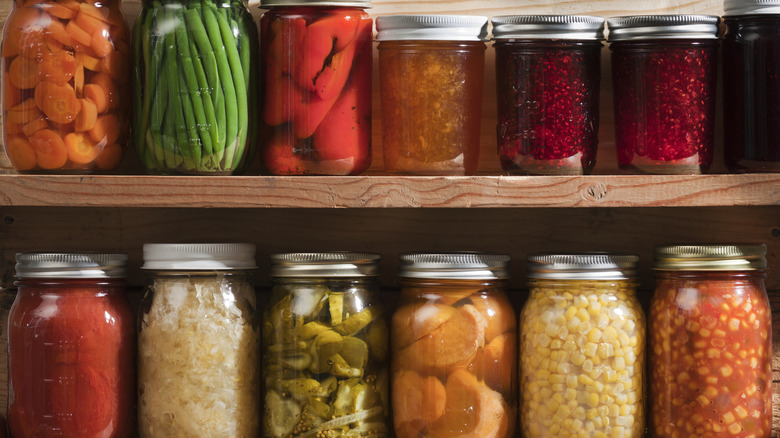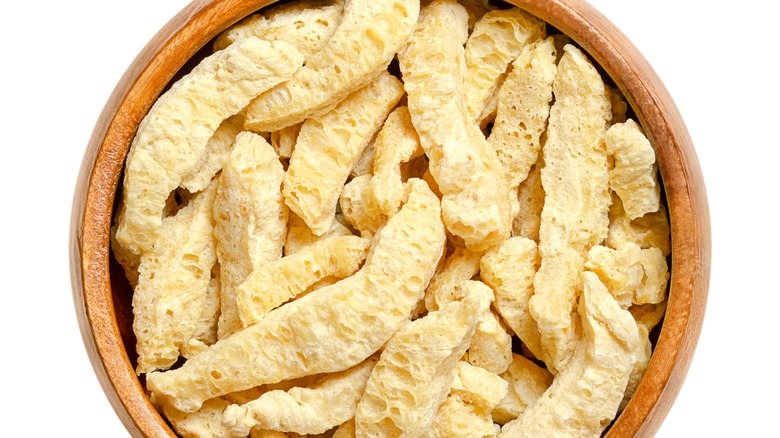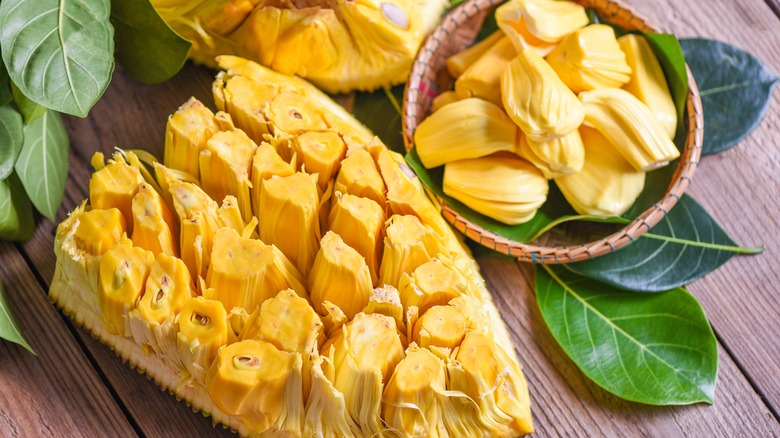20 Vegan Ingredients You Need To Spruce Up Your Grain Bowls
Grain bowls are the quintessential easy summer lunch food. The base components of a balanced grain bowl include carbohydrates, protein, and fat — but these components are relatively easy to customize depending on what you want to have in your bowl. Typically, grain bowls feature their namesake grain as the carbohydrate, and a dressing or sauce as the fat component. In addition, you can make the bowl gluten-free, include animal protein-based (including elements like grains boiled in chicken stock, meat, eggs, or seafood), or, our personal favorite — vegan.
Vegan grain bowls are the perfect way to dip your toe into eating the plant-based diet without taking the plunge head-first. If you opt to use a vegan protein, you can fill your fork with the other components, too. This is especially helpful for folks that may not enjoy the textures of some vegan proteins like tofu or tempeh. You'll also get to play around with different tastes, textures, and consistencies, all while enjoying a filling meal that can be served warm or cold. Here are some vegan components you should add to your next grain bowl.
Quinoa
Quinoa is one of our go-to grain bowl bases for several reasons. This powerful superfood contains the nine amino acids needed to form proteins, which is not often found in other vegan proteins. One cup of cooked quinoa contains 8 grams of protein and 5 grams of fiber, meaning that this grain will keep you fuller for longer than rice or other carbohydrates. Quinoa is also a source of manganese, magnesium, folate, and thiamin.
Quinoa is an excellent ingredient in grain bowls because it has a nuanced flavor and is naturally gluten-free. Red quinoa is the base of our California avocado grain bowl; it provides a colorful contrast to the avocado and turmeric dressing. We recommend cooking your quinoa in vegetable broth or stock for more flavor.
Tempeh
If you like the grainy texture of rice and millet, you'll love tempeh. Tempeh is a fermented soybean ingredient that's a staple in Indonesian cuisine. It's primarily made with fermented soybeans, but you may find an array of other grains included in your tempeh block, including millet, barley, buckwheat, and quinoa. Tempeh is a protein-rich addition to a vegan grain bowl; 1 cup contains upwards of 31 grams of protein — almost as much as a serving of beef. And since tempeh contains many different grains, you'll get an added fiber boost when you choose to adorn your vegan grain bowl with this protein, too.
You can add tempeh to your vegan grain bowl in many different ways. If you don't like the astringent taste of tempeh, try steaming it before you pan-fry or bake it. Tempeh works well with an abundance of marinades and flavors, including soy sauce, peanut sauce, and sesame oil.
Edamame
If you're looking for a protein-rich addition to your grain bowl with an organic, veggie-forward consistency, add edamame. Edamame contains the highest amount of protein per serving of any type of bean; 1 cup of edamame contains close to 29 grams of protein. It is also a rich source of folate, vitamin K, and iron.
Edamame can be sold in its shell or pre-hulled. It is important not to eat the edamame shells because the consistency is waxy and hard to digest. The edamame bean, a soybean, is buttery in flavor, soft, and much easier to eat than the soybeans processed into tofu and other soy products. Once you have your edamame beans, sprinkle them on your bowl to boost the plant-based protein content.
Avocado
Avocado is a staple ingredient for grain bowls — for more reasons than just its bright color. Avocado provides a textural contrast like no other and a healthy dose of fat to go along with it. Fat has the highest amount of calories per gram of any of the macronutrients (protein, fats, and carbohydrates), meaning that it will keep you satiated for a long time.
Avocados have a slightly earthy but relatively nuanced flavor, making them an excellent choice for diverse grain bowl flavors. For example, you can make a sushi-style grain bowl with sushi rice, avocado, cucumbers, and your protein of choice. Or, think Mediterranean with chickpeas, hummus, cucumbers, diced tomato, cabbage, and avocado. We recommend slicing your avocado thinly and spreading it around your bowl so you get a bit of a creamy texture in each bite.
Hummus and tahini
If you're anything like us, you've had hummus and veggies for a lazy dinner here and there. But this same ingredient can boost fat and protein in your grain bowl and double as a dressing. This chickpea spread can be infused with unique ingredients like roasted red peppers, garlic, or herbs like parsley to help bolster your bowl and define your flavor profile. While Mediterranean-themed bowls are popular for hummus, we especially recommend pairing the spread with roasted veggies like cauliflower, sweet potatoes, and zucchini.
If you're looking for a fat with a bit of a thinner texture, you can opt to use just tahini instead. Tahini is a thin sesame paste; you can drizzle it onto your bowl before serving or use it as an ingredient in your protein marinade.
Tofu
Tofu is likely most people's go-to addition to a grain bowl for its accessibility. You can buy a block of tofu from the grocery store, drain it, and add it to your grain bowl without a second thought. But to truly make tofu shine, you must take a couple of extra preparation steps.
First, we recommend starting with a firm or extra firm tofu. This is especially important if you plan on baking your tofu before you add it to your grain bowl. Another tip you need when preparing tofu is tossing it in cornstarch to help soak up any leftover water. For pan-searing tofu, you can utilize an overnight marinade to help infuse your flavor into an otherwise bland protein. Finally, we recommend pairing it with soy sauce, sesame oil, and coconut aminos.
Beans
Beans, beans, they're good for your heart. The more you eat, the more you... we'll leave it there for now.
Beans are great for grain bowls; depending on the type of bean you choose, you'll get a myriad of textures and flavors on your palate. Popular bean options for grain bowls include black beans, kidney beans, and chickpeas. It's safe to eat canned beans without heating them up because they are already pre-cooked. But you may want to take some special care to remove the salty brine that the beans are in since the brine can make your bowl too salty. Once your beans are drained and rinsed, you can add spices like garlic powder, chili pepper, or onion powder to help make the flavor a little more dimensional.
Farro
Farro is the queen of grain bowls (sorry, quinoa). It has a notably nutty undertone with a very thick, soft texture that makes biting into every spoonful of it enjoyable. Farro is the ancient grain that should be on your radar because of its impressive nutritional resume, as well as how well it interacts with other veggies and proteins. A ¼ cup of farro contains 6 grams of protein and 5 grams of fiber. This amount of fiber is significantly higher than rice and couscous and comparable to quinoa. The grain is also difficult to overcook, making it ideal for grain bowl novices.
There are numerous ways to use farro in a grain bowl. Since the texture of the grain is very chewy and robust, we recommend combining it with ingredients like soft sliced cucumber or avocado, nutty tempeh, and a creamy almond butter or peanut butter dressing.
Miso
Have you ever heard of miso? This paste is made from fermented soybeans that have been inoculated with mold spores (appetizing, we know) called koji. You can purchase several types of miso pastes, white being the least intense, yellow being the middle ground, and red being the strongest in flavor. While white and yellow miso has some flavor, we recommend using red miso for your grain bowls because of its complexity and because it stands out from other ingredients. So while miso might not be an ingredient that you can add directly to your grain bowls, it is an ingredient that you can incorporate into many elements within your bowl.
We love making a miso-tahini sauce for the dressing; the red miso provides an umami undertone complemented by the acidity of the vinegar, the sharpness of the sake, and the intense aroma of the sesame oil. You can also use the miso as a marinade ingredient to complement tofu, seitan, or tempeh.
Rice
Rice is the bread and butter of the grain bowl. And while we would argue there are a ton of other grains with a better nutritional profile and more oomph than the humble rice grain, there is a fair amount of playing around you can do with rice. Start by picking a type of rice that enhances the ingredients in your rice bowl.
Wild rice, for example, has a woodsy profile that is best when mixed with ingredients like mushrooms, garlic, and roasted veggies. If you like a more fibrous texture from your grain but not the deep flavor of wild rice, try brown rice. Lastly, if you're making a California roll bowl, you might want to stick with sushi rice or short-grain white rice that won't distract from the seaweed, avocado, and cucumber.
Hemp seeds
Dressing and sauces aren't the only way to get a healthy dose of fat into your bowl. Adding a sprinkle of hemp seeds to the top of your grain bowl is an easy way to add fat to your bowl without disrupting the flavor of the other more upfront bowl components. You should also add more hemp seeds to your diet because hemp seeds are a good source of plant-based protein and micronutrients. One 30-gram serving (approximately 3 tablespoons) contains nearly 10 grams of complete protein. In addition, the seeds are exceptionally high in arginine, which benefits the heart.
Hemp seeds are also a good source of fiber but should be purchased with hulls on to maximize this nutritional benefit. Shelled hemp seeds contain 1.2 grams of fiber per 30-gram serving.
Lentils
If you aren't a fan of beans, we can't promise you will also be a fan of lentils. But, if you feel like doing some exploring, lentils are a great way to add a boost of protein and fiber to your grain bowl. You can seamlessly mix lentils in with your grain base or beans or serve them in a separate part in the bowl.
One of our favorite ways to add lentils to a grain bowl is through a Middle Eastern dish called mujadara. Traditional mujadara is made by combining whole large brown lentils with rice, caramelized onions, and seasonings like cumin. The standard rice variety used is a white long-grain, but this can be substituted with other types of rice or grains as well. It is crucial to use brown or green lentils rather than red or orange because the former varieties tend to keep their shape better rather than turning to mush.
Nut butters
Looking for healthy fats and flavor? Try adding nut butter to your bowl's sauce. Nut butter adds a viscous element to the sauce that can't be replicated with many other ingredients.
There are several different types of nut butter to choose from. Peanut butter lends well to Thai and Asian flavors. You can coat your tofu in a peanut butter sauce using your favorite brand of creamy melted peanut butter, fresh lime juice, tamari or soy sauce, and chili flakes (for a bit of heat). We recommend adding a bit of chopped peanuts to your bowl, too. If you want a more nuanced flavor from your nut butter, you should try to stick with almond butter. It has a very organic flavor that isn't as dominant as peanut butter. Almond butter works well for drizzling over roasted veggies and can add a subtle sweetness to your bowl.
Couscous
Couscous is a puffy grain made from semolina wheat cooked similarly to rice. Couscous is different from Israeli couscous (or pearl couscous) by means of size and flavor. Israeli couscous resembles a more pearled shape with a noticeable softness and chewiness. Couscous has a similar texture to quinoa and can be easily substituted in a grain bowl, while Israeli couscous remains a more popular option for soups and stews, instead.
If your couscous is turning out bland, try cooking it in vegetable stock instead of plain water. You can also infuse the flavors of your grain bowl into the stock. If you're making a Mediterranean bowl with a couscous base, try cooking your couscous with saffron, cumin, or coriander for a more flavorful carbohydrate.
Roasted veggies
There are more ways to add carbohydrates to your bowl than just grains. Roasted veggies are a great way to sneak some fiber, vitamins, and minerals into your bowl. Some of our favorites to include in grain bowls are carrots, parsnips, fennel, and squash.
The key to roasting vegetables for a grain bowl is to utilize a ton of herbs, spices, and seasonings to help amp up the flavors and create harmony amongst your bowl components. For example, we recommend making honey-glazed carrots (substitute maple syrup for the honey, of course), to add an element of sweetness to your bowl. These sweet carrots pair well with a tahini drizzle or a bright vinaigrette dressing. You can also make herb-roasted root vegetables with the help of garlic, dried rosemary, and thyme. These herbs don't conflict with many toppings, making this recipe versatile enough to add to almost any grain bowl.
Potatoes
Potatoes are carbohydrate-dense starches that add a bit more texture to your bowl than just rice. You can opt for regular potatoes (the best potatoes for roasting include reds, Russets, and Yukon Golds), or go the sweet potato route.
One of the potential drawbacks to using potatoes in your bowl is that they get a little too starchy and tend to overwhelm the other consistencies present. To counteract this, try cutting your potatoes into small pieces and using them in addition to a grainy starch rather than their own stand-alone component. We tend to prefer roasted potatoes for grain bowls because the consistency is more well-rounded than other forms of potatoes. In addition, you can add more flavors to your roasted potatoes by tossing them with dried rosemary, oregano, and thyme before baking or using a pre-made mix (like taco seasoning).
Chopped leafy greens
Leafy greens as the textural and colorful boost you didn't know your grain bowl needed. There are tons of different leafy greens you can add to your grain bowl depending on whatever you have left over in your fridge. Some of our favorites include chopped red cabbage, fresh baby spinach, and arugula. Just make sure you don't use too many leaf greens, or your grain bowl may just turn into a salad.
There are some leafy greens that you can chop directly into your salad, while others require you to do a little bit of prep work ahead of time. Kale, for example, requires you to de-stem it and massage it to make it easier to digest before you can add it to your grain bowl.
Pickled veggies
Grain bowls are all about playing with different flavors. One of the easiest ways to achieve a sour element in your grain bowl is to add pickled veggies. Pickled veggies aren't just your standard brined deli pickles; you can also add pickled radishes, red onions, and jalapeños for a bright, tangy flavor and a vegetal component.
When adding pickled veggies to your grain bowl, you'll want to avoid adding a disproportionate amount of these ingredients — which would cause you to detract from the savory or umami flavors in your bowl. Instead, add a little garnish of pickled jalapeños to the top of a Tex-Mex grain bowl — but don't make it a star ingredient. Add a spoonful of spicy kimchi if you're making an Asian-themed bowl.
Soy curls
Sometimes, you just want to add chicken to your grain bowl. We get it. But, if you're a vegan, you must search for a viable, plant-based alternative. Soy curls have the most chicken-like texture of all the types of vegan protein alternatives. These textured chunks are made with textured vegetable protein, a de-fatted soy product, extruded into its chicken-tender-like shape. You can rehydrate 1½ cups of soy curls with 2 cups of warm water or stock for about 10 minutes and then sauté the curls as you would chicken breast.
The best thing about soy curls is that they absorb the flavor of whatever you're cooking with — meaning it's very easy to manipulate the flavor. You can use your favorite teriyaki sauce, jerk seasoning, or household blend to add a unique flavor profile to your soy curls.
Jackfruit
Jackfruit has started to blossom on the vegan food scene as a meat alternative, but can it be used in a grain bowl? This massive, prickly fruit is native to Asia but can be found in the canned foods sections of most Asian ethnic grocery stores or online retailers. Jackfruit is best when it's cooked and used as a meat replacement for everything from tacos to pulled "pork."
Like other types of meat alternatives, jackfruit soaks up the seasoning of whatever it's cooked with. Raw jackfruit is bland and mild in flavor but can be easily elevated with the inclusion of herbs, spices, or pre-made seasonings. Its texture is also stringy, so it likely won't be an effective replacement for meats like chicken or delicate cuts of seafood. We recommend shredding it and adding it to your bowl with rice, pickled veggies, and fresh cabbage for crunch.
